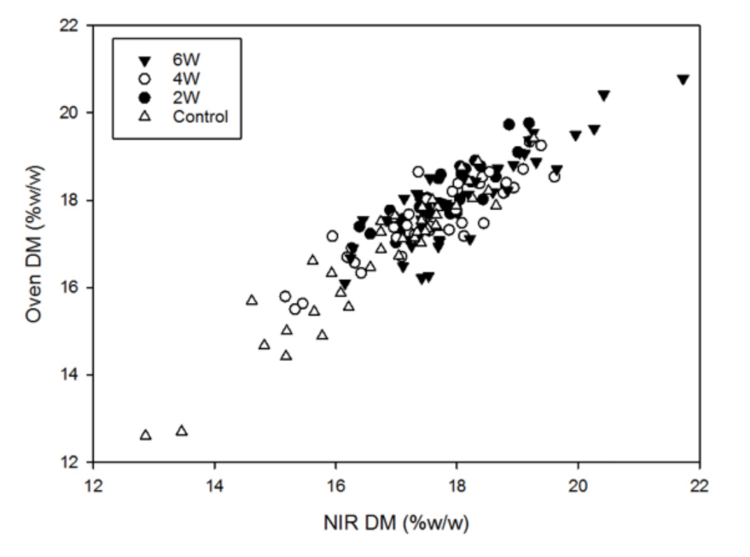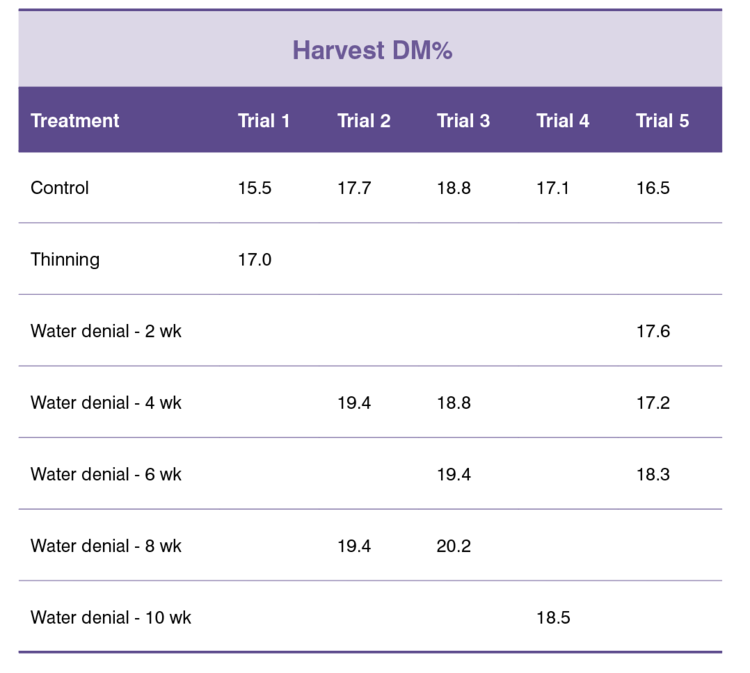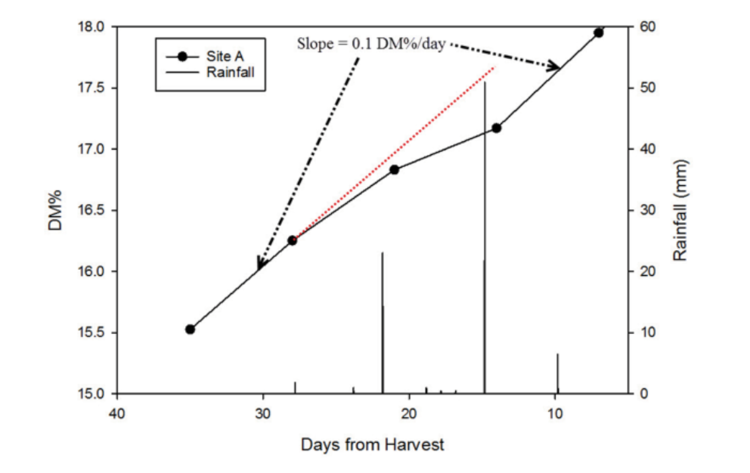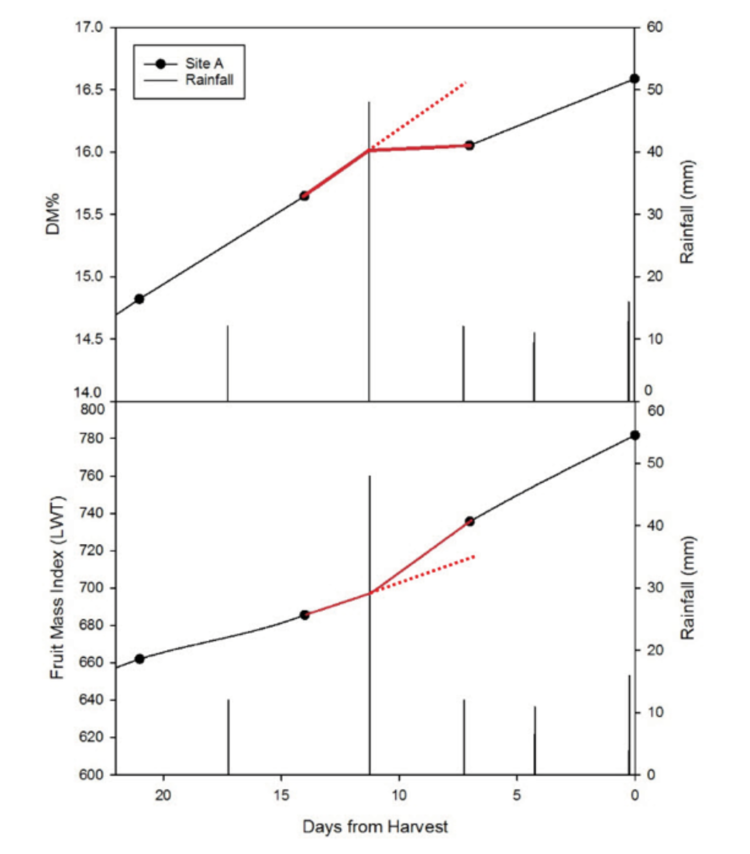Factors that influence dry matter
This article provides an overview of dry matter (DM) and fruit maturity in mangoes and outlines the results of trials conducted by Central Queensland University (CQU) to identify methods to increase fruit DM. It also discusses reliability of using near infrared spectroscopy (NIR) technology to measure DM.
DM and eating quality
DM of a fruit is what is left after water is removed. The DM of a fruit is composed of a fixed amount of cell walls, fats and proteins, and a variable amount of sugars and starch. DM content is therefore an index of the sugar and starch content of the fruit, with DM varying from around 11% (dry weight as a percentage of fresh weight) in flesh of fruit at the stone hardening stage and to up to 22% (or more) as the fruit reaches full maturity.
As the fruit matures it accumulates a lot of starch and some sugar. As the fruit ripens, starch is converted to sugar. Thus, the DM of fruit at harvest is a good indicator of the sugar content of the fruit when fully ripe, and thus of eating quality.
Major retailers regularly include minimum DM standards in the quality specifications and research conducted by Queensland Department of Agriculture and Fisheries (QDAF) in association with Hort Innovation and AMIA provided the data to amend several of these minimum standards.
DM is traditionally measured by oven drying a sample of fruit, but can also be measured non-destructively using near infrared spectroscopy (NIR).
Bottom line: DM indexes starch and sugar levels, which relates to eating quality in ripe fruit. For this reason, AMIA has set recommended minimum DM levels, by variety, and NIR DM is being checked in markets and on farms.
How reliable is the NIR measurement method?
The F-750 Produce Quality Meter was used to measure DM of fruit from trees subject to irrigation water denial two to six before harvest. DM was also determined by the oven method. NIR and oven methods were in agreement (Figure 1).

Figure 1. Oven and NIR measurements of DM of fruit for trees denied water for zero, two, four and six weeks before harvest.
When calibrated, the F-750 Produce Quality Meter is a reliable method for rapid estimation of DM. In field DM assessments can be used to guide the decision to pick in terms of the order of harvest of blocks within a farm, and to ensure a minimum specification is achieved.
DM and fruit maturity
The term ‘maturity’ can be better defined in terms of:
- A fruit is physiologically mature when it reaches a stage at which it will continue development even if detached from the plant
- A fruit reaches harvest maturity after physiological maturity, when it has desired levels of skin and flesh colour, shape and DM
- A fruit reaches consumer maturity when it is ready to eat—for mango this is after ripening
- Fruit ripening involves change in skin and flesh colour, decrease in firmness, conversion of starch to sugar and increase in volatiles (a fruit’s chemical elements), and can occur on or off the tree, but only once the fruit is physiologically mature.
So what do DM levels tell us about harvest maturity?
Of course there is some flexibility in the time of harvest—the longer time on tree, the more chance for starch and sugars to accumulate in the fruit, but the fruit will start to ripen on the tree, and so shelf life will be reduced. The decision to pick is guided by this compromise. The fruit should be mature enough to continue to ripen after harvesting, have enough DM to meet or exceed the minimum specification (and thus achieve a good eating quality in ripened fruit), but not be so far advanced as to compromise shelf life.
Thus, the DM of the fruit at harvest maturity is determined by how long the fruit is left on the tree (with more time to accumulate starch, sugar and higher DM) and growing conditions (more photosynthesis giving more DM).
Growers using DM to guide the decision to pick can cut some fruit to assess flesh colour to develop a DM target. In our general experience, Calypso and KP achieve a harvest maturity at which flesh colour is acceptable when 90% of fruit have a DM of 15% or higher, or a mean of about 16.5% DM.
Note that if fruit have an average of 15%, half of the fruit have a DM lower than this level. Southern growers targeting a late market may choose to target a higher DM and later harvest.
Bottom line: DM level is a very useful aid in the decision to pick and for deciding the order of block harvest.
Manipulating DM
So what can be done if the DM of fruit in a block is below the industry minimum specification?
The following treatments have been previously reported in work done in Australia and overseas as resulting in increased fruit DM:
- Fruit thinning (which also increases fruit size)
- Girdling of branches two months after flowering (which also increases fruit size)
- Bagging of fruit
- Water deficit (if early in the fruit development period this can decrease fruit size).
We repeated some of these treatments while using NIR to continuously monitor DM of fruit on treated trees, and found:
- Thinning fruit on the tree six weeks before harvest resulted in increased DM content of remaining fruit, although obviously at the cost of fruit number
- Girdling of the tree trunk (as practiced by some growers to induce flowering) six weeks before harvest failed to impact fruit DM. Possibly the depth of the cut was too shallow
- Bagging of fruit six weeks before harvest did not change fruit DM
- Denial of irrigation water from two to ten weeks before harvest resulted in increased fruit DM (Table 1). The longer duration treatments also resulted in decreased fruit size.

Table 1. DM of fruit at harvest for a number of treatments over a number of years at several locations.
Across this range of treatments and growing conditions, we have observed rates of DM increase between 0.07- 0.14% DM/day.
Bottom line: The easiest way to increase fruit DM is to leave the fruit on the tree as long as possible. The most practical way to increase DM without extending the growth window is to halt irrigation (approximately two weeks) before harvest.
What happens when it rains?
A grower can only control irrigation, but not rainfall. A high rainfall event (for example >30 mm) will see water move down the soil profile, and the water uptake by the plant results in an increase in fruit size. This size increase effectively ‘dilutes’ the fruit carbohydrate content, and the rate of DM accumulation decreases (Figure 2, 3.).
Bottom line: Rain can cause increase in fruit size, and decrease in the rate of DM increase.

Figure 2. An example from 2015: Rainfall is shown on the right side, fruit DM on the left. The rainfall events of approximately 20 and 50 mm at 23 and 16 days before harvest caused a temporary decrease in the rate of DM accumulation.

Figure 3. An example from 2016: a 50mm rain event resulted in a decrease in the rate of DM increase in the size of the fruit.
Does water stress increase rate of fruit ripening?
Fruit from water denied (zero, two, four and six weeks before harvest) trees were either left until full ripe (‘hanging time’) or harvested and ripened at a constant 20˚C. The time to ripen and the hanging time of fruit was slightly shorter (but not statistically significantly) in water denied treatments.
Water loss from fruit during cool store in low humidity conditions will obviously also impact DM. An extreme amount of water loss will also impact fruit firmness and thus mouth-feel/eating experience. However it is possible that modest water loss could result in higher DM/ripe stage brix and thus eating quality. Further consideration of this treatment is recommended.
Bottom line: Mild pre-harvest water stress treatments do not impact fruit ripening behaviour.
Summary—tools to manipulate DM
To increase DM to achieve market specifications, the following ‘tools’ can be considered:
- Location of orchard—areas of high sunshine/high photosynthetic potential will result in higher DM at harvest
- Canopy architecture and fruit load—to optimise leaf to fruit ratio. The current high density tree crop trial underway with QDAF will likely provide further information in this area
- Based on our trial, trees can be denied irrigation water two weeks before harvest to increase DM without impact on fruit size. A shorter water deficit period (for example two to four weeks) is preferred over a longer period (for example six to eight weeks), given the potential for the longer treatments to decrease fruit size. Large rainfall (or presumably irrigation) events will halt DM increase and increase fruit size.
Article submitted by Professor Kerry Walsh and MSc candidate Nicholas Anderson, CQU, Rockhampton.
Acknowledgements: We appreciate the continuing support of Martina Matzner, Acacia Hills Farms, and the past support of Oolloo Farms. This work was supported by Hort Innovation project MT14048, Multiscale monitoring of tropical fruit trees.